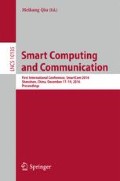Abstract
A generalized longest common subsequence problem is studied in this paper. In the generalized longest common subsequence problem, a constraining sequence of length s must be included as a substring and the other constraining sequence of length t must be excluded as a subsequence of two main sequences and the length of the result must be maximal. For the two input sequences X and Y of lengths n and m, and the given two constraining sequences of length s and t, we present an O(nmst) time dynamic programming algorithm for solving the new generalized longest common subsequence problem. The time complexity can be reduced further to cubic time in a more detailed analysis. The correctness of the new algorithm is proved.
Access this chapter
Tax calculation will be finalised at checkout
Purchases are for personal use only
References
Chen, Y.C., Chao, K.M.: On the generalized constrained longest common subsequence problems. J. Comb. Optim. 21(3), 383–392 (2011)
Crochemore, M., Hancart, C., Lecroq, T.: Algorithms on Strings. Cambridge University Press, Cambridge (2007)
Deorowicz, S.: Quadratic-time algorithm for a string constrained LCS problem. Inform. Process. Lett. 112(11), 423–426 (2012)
Deorowicz, S., Obstoj, J.: Constrained longest common subsequence computing algorithms in practice. Comput. Inform. 29(3), 427–445 (2010)
Gotthilf, Z., Hermelin, D., Lewenstein, M.: Constrained LCS: hardness and approximation. In: Ferragina, P., Landau, G.M. (eds.) CPM 2008. LNCS, vol. 5029, pp. 255–262. Springer, Heidelberg (2008). doi:10.1007/978-3-540-69068-9_24
Gotthilf, Z., Hermelin, D., Landau, G.M., Lewenstein, M.: Restricted LCS. In: Chavez, E., Lonardi, S. (eds.) SPIRE 2010. LNCS, vol. 6393, pp. 250–257. Springer, Heidelberg (2010). doi:10.1007/978-3-642-16321-0_26
Gusfield, D.: Algorithms on Strings, Trees, and Sequences: Computer Science and Computational Biology. Cambridge University Press, Cambridge (1997)
Peng, Y.H., Yang, C.B., Huang, K.S., Tseng, K.T.: An algorithm and applications to sequence alignment with weighted constraints. Int. J. Found. Comput. Sci. 21(1), 51–59 (2010)
Tang, C.Y., Lu, C.L.: Constrained multiple sequence alignment tool development and its application to RNase family alignment. J. Bioinform. Comput. Biol. 1, 267–287 (2003)
Tseng, C.T., Yang, C.B., Ann, H.Y.: Efficient algorithms for the longest common subsequence problem with sequential substring constraints. J. Complex. 29, 44–52 (2013)
Acknowledgement
This work was supported by Intelligent Computing and Information Processing of Fujian University Laboratory and Data-Intensive Computing of Fujian Provincial Key Laboratory.
Author information
Authors and Affiliations
Corresponding author
Editor information
Editors and Affiliations
Rights and permissions
Copyright information
© 2017 Springer International Publishing AG
About this paper
Cite this paper
Wang, X., Zhu, D. (2017). Efficient Computation for the Longest Common Subsequence with Substring Inclusion and Subsequence Exclusion Constraints. In: Qiu, M. (eds) Smart Computing and Communication. SmartCom 2016. Lecture Notes in Computer Science(), vol 10135. Springer, Cham. https://doi.org/10.1007/978-3-319-52015-5_43
Download citation
DOI: https://doi.org/10.1007/978-3-319-52015-5_43
Published:
Publisher Name: Springer, Cham
Print ISBN: 978-3-319-52014-8
Online ISBN: 978-3-319-52015-5
eBook Packages: Computer ScienceComputer Science (R0)

